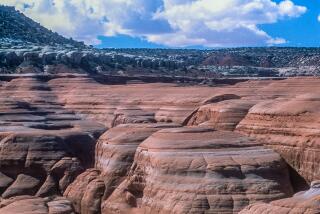Snowmobile War Redux
- Share via
Snowmobiles don’t belong in Yellowstone and Grand Teton national parks, no matter how much the Department of the Interior wants to appease snowmobile manufacturers and related businesses. The winter fastness of these parks should be as inviolable as in the wilderness of Yosemite National Park, where the roaring, polluting machines never have been allowed.
The National Park Service has completed still another study of snowmobile use in the parks and come up with little or no new information. Now the Park Service is seeking yet more public comment before deciding in November whether to implement a ban that was scheduled to begin with the winter of 2003-04.
The last time the Park Service requested comment, two years ago, more than 80% of the thousands who responded supported the ban. This time, the snowmobile industry may be better at drumming up support, but ordinary citizens still can make themselves heard.
Area leaders are concerned the ban will hurt the local economy, especially that of West Yellowstone, Mont., a major entry point for snowmobilers. But the new study says that any of the alternatives will produce less than a 1% decline in jobs and business dollars.
The Interior Department ordered the new study as part of its friendly settlement of a lawsuit brought by snowmobile manufacturers and the states of Montana and Wyoming to overturn the ban, which was instituted by the Clinton administration. The ban was approved in November 2000 after more than a decade of study of the harm done by snowmobile pollution and noise on the park environment.
Snowmobile makers insist that their new four-stroke engines are quieter and less polluting than the old models. That’s true. But even the new machines disrupt wildlife and threaten public safety and the enjoyment of other park visitors.
The new study offers four alternatives: Retain the ban beginning in 2003-04; delay the ban until 2004-05; impose a daily cap on snowmobiles and phase in new noise and air quality standards; permit only guided touring on machines driven by Park Service personnel.
The logical choice is to stick with the ban the Park Service has planned all along.
The Park Service has started tours to Old Faithful, the most popular snowmobile destination, by snow coach, although the coaches themselves are reported to be pretty noisy. The service, with Congress’ help, should develop quieter coaches and expand the fleet to handle the demand for those who truly want to visit Yellowstone in winter. These include cross-country skiers and snowshoers hoping not to be chased from their trails and out of their solitude by a snarling snow machine.
As for the snowmobilers, who talk about the thrill of the wind in their faces, they can get all the wind they want in the millions of acres of national forest lands that surround the parks.
*
To take action: Submit comments by e-mail to grte_winter_use_seis@nps.gov or by regular mail to Winter Use SEIS, P.O. Box 352, Moose, WY 83012. The environmental impact statement can be viewed at www.nps.gov/grte/winteruse/intro.htm.
More to Read
Sign up for Essential California
The most important California stories and recommendations in your inbox every morning.
You may occasionally receive promotional content from the Los Angeles Times.













